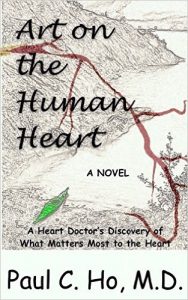 Art on the Human Heart by Paul C. Ho is the story of a cardiologist who has a heart attack, which makes him re-evaluate his life. It also makes him re-evaluate the medical profession, as he attempts to understand what affects the human heart well beyond medical science. Going through his life as a young immigrant, a failed relationship, a stint being a doctor in the Alaskan wilderness, his personal mysticism, and more, the doctor comes to a greater understanding of the human heart than he had before his illness.
Art on the Human Heart by Paul C. Ho is the story of a cardiologist who has a heart attack, which makes him re-evaluate his life. It also makes him re-evaluate the medical profession, as he attempts to understand what affects the human heart well beyond medical science. Going through his life as a young immigrant, a failed relationship, a stint being a doctor in the Alaskan wilderness, his personal mysticism, and more, the doctor comes to a greater understanding of the human heart than he had before his illness.
The blurb for this novel, and the title, suggest that the book might be laden with treacly sentimentality, but it is nothing of the sort. The character of Dr. Paul (as he is known at the hospital) is such a hard-ass that he cannot for a moment come across as sentimental. He’s so tense and mean-spirited, that it’s somewhat unsurprising he has a heart attack, even at 39. But it’s this cynicism that makes his eventual transformation and discovery more meaningful.
Ho brings his substantial expertise to the novel, which brings the novel credibility and a great amount of colorful detail. The novel goes well beyond “doctor writing a novel” into another territory, as the character in the novel is named Paul Ho, and the author himself is a cardiologist who suffered from a heart attack. Sometimes, Ho’s description of medical procedures is too dry, as the cardiologist comes through, rather than the novelist. An example:
PCI would be much less invasive. Unclogging the blockages is done from inside the blood vessels using long plastic tubes called catheters. These catheters can reach blockages deep within the body by threading along the arterial highway system. Balloons or cutting tools mounted at the tip can clear the blockages that have grown to tight for comfort. Placement of a stent, a metallic scaffold, is the final step to ensure a permanent open channel in the soft blood vessel.
Some may enjoy getting a crash course in cardiology, but as this is a novel, and not a memoir, the prose is a bit too much on point for narrative fiction.
Likewise, there are long bouts of dialog in which Dr. Paul tells stories about his life and upbringing that seem better suited for straight prose. So the novel seems a bit confused of its identity: on the one hand, it wants to be a memoir, even down to the protagonist’s name, and then puts character description in dialog to make it read more like a novel. This is not quite enough to term the book fiction.
These criticisms aside, Art on the Human Heart is a riveting read. Ho has led a remarkably interesting life, and he describes it well. He’s a highly likable narrator, no matter the confusion whether the book is a memoir or novel. You will keep reading because he’s such an ambitious person with an admirable personal drive. So overall, the book is an illuminating and informative read, whatever its deficiencies. It’s a shame that that the narrative structure wasn’t as focused as his voice, but overlooking that issue, the novel is an uplifting story about appreciating all that life has to offer.
Links
Amazon
Goodreads
Review Overview
Design
Editing
Content
Get an Editorial Review | Get Amazon Sales & Reviews | Get Edited | Get Beta Readers | Enter the SPR Book Awards | Other Marketing Services























Leave A Comment